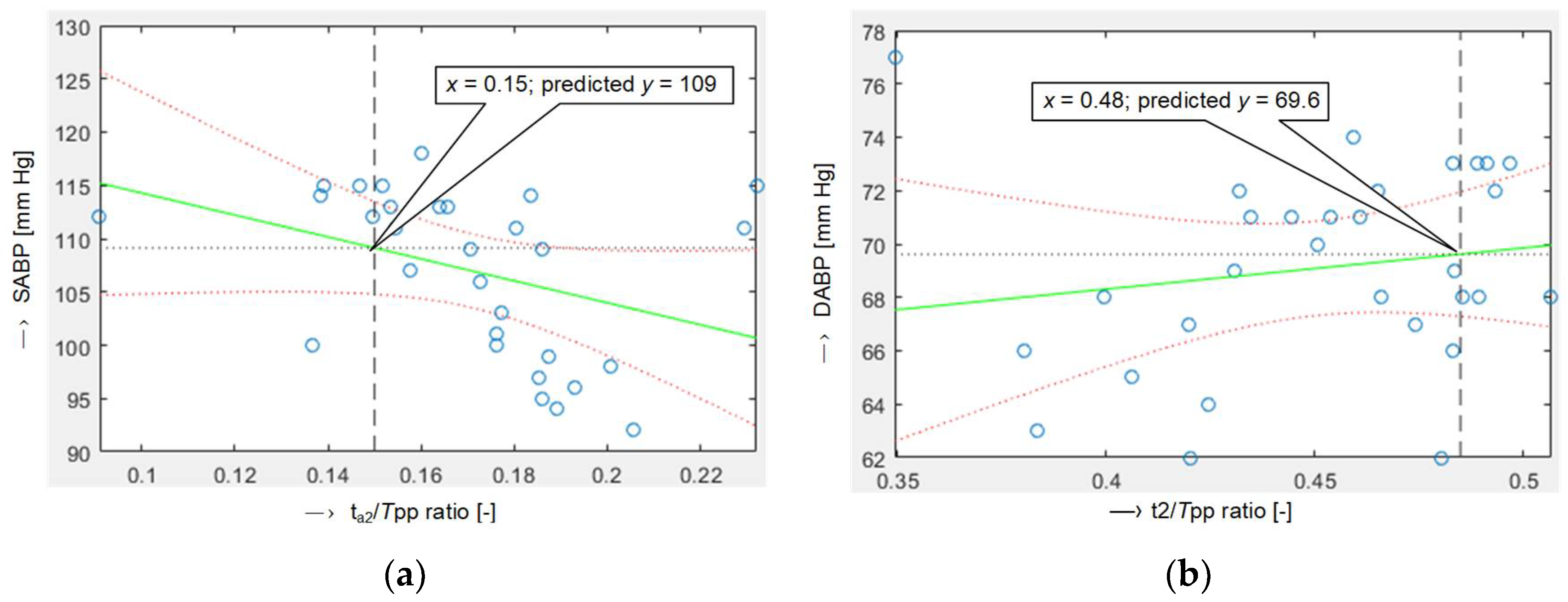Experiment with Cuffless Estimation of Arterial Blood Pressure from the Signal Sensed by the Optical PPG Sensor †
Abstract
1. Introduction
2. Methods
2.1. Methods of Determination of ABP Values from PPG and ECG Signals
2.2. Method of PPG Wave Features Determination and Estimation of SABP/DABP Values
3. Description of the Used PPG Signal Database, Experiments, and Results
4. Discussion and Conclusions
Author Contributions
Funding
Institutional Review Board Statement
Informed Consent Statement
Data Availability Statement
Conflicts of Interest
References
- Přibil, J.; Přibilová, A.; Frollo, I. First-step PPG signal analysis for evaluation of stress induced during scanning in the open-air MRI device. Sensors 2020, 20, 3532. [Google Scholar] [CrossRef] [PubMed]
- Steckner, M.C. A review of MRI acoustic noise and its potential impact on patient and worker health. eMagRes 2020, 9, 21–38. [Google Scholar]
- Celka, P.; Charlton, P.H.; Farukh, B.; Chowienczyk, P.; Alastruey, J. Influence of mental stress on the pulse wave features of photoplethysmograms. Healthc. Technol. Lett. 2020, 7, 7–12. [Google Scholar] [CrossRef] [PubMed]
- Yoon, Y.-Z.; Yoon, G.-W. Nonconstrained Blood Pressure Measurement by Photoplethysmography. J. Opt. Soc. Korea 2006, 10, 91–95. [Google Scholar] [CrossRef][Green Version]
- Liu, M.; Lai-Man, P.; Fu, H. Cuffless blood pressure estimation based on photoplethysmography signal and its second derivative. Int. J. Comput. Theory Eng. 2017, 9, 202. [Google Scholar] [CrossRef]
- Slapnicar, G.; Luštrek, M.; Marinko, M. Continuous Blood Pressure Estimation from PPG Signal. Informatica 2018, 42, 33–42. [Google Scholar]
- Teng, X.F.; Zhang, Y.T. Continuous and Noninvasive Estimation of Arterial Blood Pressure Using a Photoplethysmographic Approach. In Proceedings of the 25 Annual International Conference of the IEEE EMBS, Cancun, Mexico, 17–21 September 2003. [Google Scholar]
- Zhang, M.; Wei, P.F.; Li, Y. A LabVIEW based measure system for pulse wave transit time. In Proceedings of the International Conference on Information Technology and Applications in Biomedicine, ITAB 2008, Shenzhen, China, 30–31 May 2008. [Google Scholar]
- Mousavi, S.; Firouzmand, M.; Charmi, M.; Hemmati, M.; Moghadam, M.; Ghorbani, Y. Blood pressure estimation from appropriate and inappropriate PPG signals using A whole-based method. Biomed. Signal Process. Control 2019, 47, 196–206. [Google Scholar] [CrossRef]
- Al-Sidani, A.; Ibrahim, B.; Cherry, A.; Hajj-Hassan, M. Biometric identification using photoplethysmography signal. In Proceedings of the Third International Conference on Electrical and Biomedical Engineering, Clean Energy and Green Computing (EBECEGC), Beirut, Lebanon, 25–27 April 2018; pp. 12–15. [Google Scholar] [CrossRef]
- Cattivelli, F.S.; Garudadri, H. Noinvasive cuffless estimation of blood pressure from pulse arrival time and heart rate with adaptive calibration. In Proceedings of the International Workshop on Wearable and Implantable Body Sensor Networks, Berkeley, CA, USA, 3–5 June 2009; pp. 114–119. [Google Scholar]
- Přibil, J.; Přibilová, A.; Frollo, I. Comparative Measurement of the PPG Signal on Different Human Body Positions by Sensors Working in Reflexive and Transmission Modes. Eng. Proc. 2020, 2, 69. [Google Scholar] [CrossRef]
- Liang, Y.; Chen, Z.; Liu, G.; Elgendi, M. A New, Short-Recorded Photoplethysmogram Dataset for Blood Pressure Monitoring in China. Scientific Data. 27 February 2018, Volume 5, p. 180020. Available online: https://figshare.com/articles/PPG-BP_Database_zip/5459299 (accessed on 19 July 2022).






| REE Type/PPG Signal | From Left Hand | From Right Hand | From Both Hands |
|---|---|---|---|
| REESABP [%] | 21.9 (11.9) | 7.5 (10.8) | 8.6 (12.1) |
| REEDAPB [%] | 15.9 (5.1) | 2.5 (0.9) | 9.8 (6.1) |
| REE Type/PPG Signal | From M1, M2 | From F1, F2 | From All Persons |
|---|---|---|---|
| REESABP [%] | 1.2 (1.2) | 13.7 (14.0) | 7.5 (10.8) |
| REEDAPB [%] | 2.2 (1.4) | 2.9 (0.01) | 2.6 (0.9) |
Publisher’s Note: MDPI stays neutral with regard to jurisdictional claims in published maps and institutional affiliations. |
© 2022 by the authors. Licensee MDPI, Basel, Switzerland. This article is an open access article distributed under the terms and conditions of the Creative Commons Attribution (CC BY) license (https://creativecommons.org/licenses/by/4.0/).
Share and Cite
Přibil, J.; Přibilová, A.; Frollo, I. Experiment with Cuffless Estimation of Arterial Blood Pressure from the Signal Sensed by the Optical PPG Sensor. Eng. Proc. 2022, 27, 51. https://doi.org/10.3390/ecsa-9-13220
Přibil J, Přibilová A, Frollo I. Experiment with Cuffless Estimation of Arterial Blood Pressure from the Signal Sensed by the Optical PPG Sensor. Engineering Proceedings. 2022; 27(1):51. https://doi.org/10.3390/ecsa-9-13220
Chicago/Turabian StylePřibil, Jiří, Anna Přibilová, and Ivan Frollo. 2022. "Experiment with Cuffless Estimation of Arterial Blood Pressure from the Signal Sensed by the Optical PPG Sensor" Engineering Proceedings 27, no. 1: 51. https://doi.org/10.3390/ecsa-9-13220
APA StylePřibil, J., Přibilová, A., & Frollo, I. (2022). Experiment with Cuffless Estimation of Arterial Blood Pressure from the Signal Sensed by the Optical PPG Sensor. Engineering Proceedings, 27(1), 51. https://doi.org/10.3390/ecsa-9-13220







